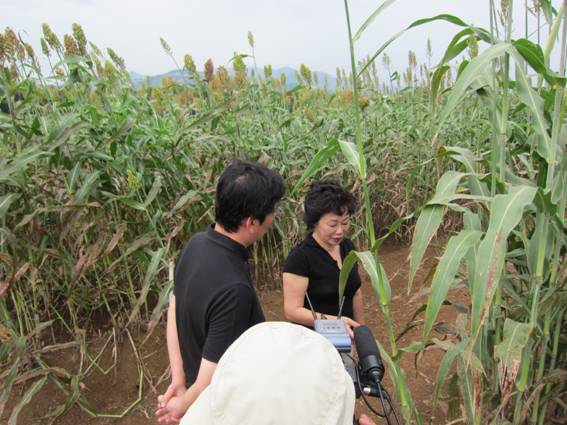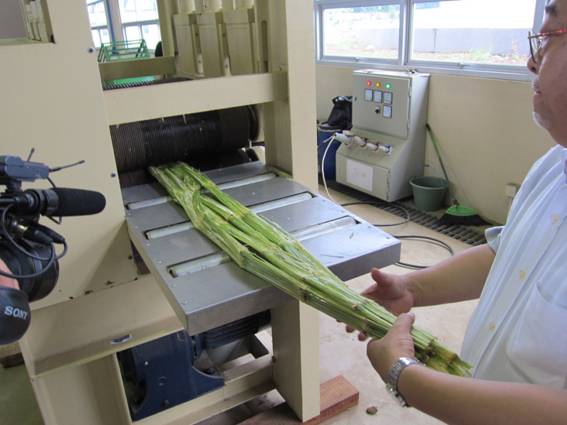I visited a plant where the bioethanol is produced from super sorghum located in a suburb of Jakarta in Indonesia for making a special TV program.
Syswave Holdings Corp. initiated this project and Mr. Sugiyama gave a tour for us. Amazingly, the main business of this company was IT and nothing related on bio fields until two years ago. They started to cultivate super sorghum in Indonesia from September 2012. How wonderful their courage and passion for overseas operations is!
By the way, you might be wondering what super sorghum is. Super sorghum is a cultivated plant like a group of sugarcane. This plant can grow rapidly and contain juice having high sugar content. Now, alternatives to petroleum are a pressing issue in the world and each country is taking action for it. Though it’s possible to produce ethanol from crops like corns, other crops as substitution are really needed because of competitive problem with crops for food. Super sorghum comes under the spotlight at such a time.
In 2008, the “Team Sorghum”, a research group consisted of researchers from Tokyo University, Nagoya University and Tokyo University of Agriculture and Technology, was formed in Okinawa and began the research about potentialities of sorghum. Objectives of the sorghum research were to increase the amount of crops, to accelerate the growth of sorghum, and to make it sweeter (15 degree of sugar content) by crossbreeding repeatedly. The team had made efforts continuously until they achieved the ideal ratio of crossbreeding which enabled the plant to increase the lactic acid bacteria after being fermented by itself.

30 types of crossbreeding are conducted in the field owned by Indonesian Institute of Science (LIPI).
Mr. Miyajima, the president of Syswave Holdings Corp., made a collaborative research proposal to LIPI with his motto, “take your chance.” The head of LIPI who had tried to produce alcohol from cassava for five years made a great decision to take this proposal last year.
I am surprised that LIPI entered into MOU (memorandum of understanding) with a nongovernmental enterprise in such a short period. In the similar cases of Japanese government, it usually takes some years to reach an agreement. Now, Tapioca is in boom around the world and tropical drinks and desserts with tapioca gain much popularity. It’s difficult to produce ethanol from Tapioca anymore because the sales price of Tapioca has gone through the roof. However, this situation is good for the sorghum project.
Super sorghum under development by Team Sorghum makes 200kg ethanol production per 2 hectare possible, so the sales price in the market will be very cheap about 50 yen per liter. It shows super sorghum has a great potential to clear conditions as bioethanol.
Super sorghum can be harvested three times in one seeding throughout a year. If you cut the root and just leave it, some sprouts appear and grow up. This easy cultivation is a key to save the cost.
Motorbike is the major means of transportation for the majority of people in Indonesia today. The government supports about 50% of gasoline price and holds the price in 50 yen at the street price, but the burden of this subsidy is very heavy for the government. So, development of cheaper bioethanol is strongly requested as the national objectives.
The juice extracting from stalks is very sweet and alcohol is produced by its fermentation in a tank. It’s extracted ethanol by distillation as well as distilled spirit. Extracted ethanol can be mixed in gasoline. This mixed gasoline brings good things such as less pollution and good mileage.

The Institute of Science has now an ambition to establish a complete recycling-based model society in this field. Bagasse is the fibrous matter that remains after sorghum stalks are crushed to extract their juice and contains a lot of mineral and sugar. Compost mixed in fermented bagasse, sorghum leaves and stalks can be used for cultivation of organic vegetables. Also, a dairy farmer can produce delicious beef by feeding diluted fermented bagasse and its manure is good for compost. There are no parts of super sorghum to waste.
If the usage of fermented bagasse and its compost is developed at higher level and is focused attention in the future, super sorghum may grow up more than 6m and be harvested 4 times a year. Now, I expect great success of this sorghum project and I think this is the shortest way that poverty stricken people in the tropical forests can get money. Crop yields per hectare are big with lighter labor. Income source is stable and less dumpling risk because the purchase is assured by the government. This business brings one good thing after another. In fact, many farmers from all parts of Indonesia have already got their hands up for it. I think it’s great.
